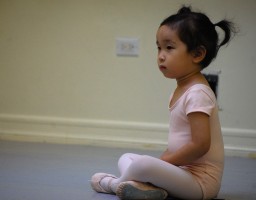“Follow me” I whisper as I sneak around the room on my toes.
As I gain more and more experience teaching little ones, I become more aware of things that work and things that don’t. One thing I know for sure is that your voice and the way you use it, is so very important. When parents come to me and say, “We tried a different class but the teacher was blah” (yes, parents have used that exact word), I automatically think about what the teacher might be missing when speaking, directing and interacting with his or her students.
The voice is so powerful. If I absolutely had no props at all and had no music, I could still teach a class that my students would love. I can recall two different times when my musician didn’t show up and my iPod died and I had to teach a whole class without music. It can be done by knowing how to use your voice. Toning up your vocal cords could be just the thing you need to make your already awesome class, more wonderful!
Here are a few ways I use my voice with my preschoolers. Keep in mind, the skill is knowing the right time to incorporate each one.
Bring it down a notch
Sometimes I catch myself with my voice too high. You know, the “gooochy goo” voice that old ladies do to babies when they see them at the grocery store? When I notice I am doing this, my students ARE NOT listening. I don’t know what it is, but they don’t respond well to a high-pitch voice. If you bring it down just one octave, I see much better results. Sooo, save your granny voice for the grocery store!
When to use it? All the time!
Noises
Kids make silly noises, so why shouldn’t you? Noises can help you establish a really great connection with your students. I have a noise for everything. Zip up your jacket (ziiiiiiiiiiiiiiip), put on your boots (shew-shew), balance on one foot (that noise you make with the tongue on the roof of your mouth. cluck?). It’s the most fun when you ask them to make up noises for their movements. We have made up some really awesome movement qualities that way. Silly noises just add another layer of engaging and fun!
When to use it? When the energy in the room is low.
Whisper
My absolute favorite way to speak to children. Honestly, if I could teach a whole class with a whisper I would! This grabs their attention so quickly. They have to try really hard to hear what you are saying and it brings the focus right to you in a split second. Sometimes, I give 3 step directions in a whisper and it’s interesting to see what they pick up. If you haven’t tried this, you must, it changes everything!
When to use it? When it’s hard to get everyone’s attention at the same time. When distractions are keeping them from being engaged.
Soft
Speaking softly is different than a whisper. If your room is loud, instead of being louder than the room, get softer. Getting louder will just cause more chaos. Personally, this is the hardest one to remember for me. Your natural instinct is to be in authority and get louder over them, but it doesn’t work. It also makes me feel better about speaking to my students. What teacher wants to yell and scream over 15 preschoolers? Being loud has it’s place, but in this case softer is better.
When to use it? When the room is loud or the students are loud.
Sing
Ok, so I’m not a Broadway singer, I have no idea if I even sound good, (doubt it) but the kids don’t care. The more directions and dances you can sing, the more interesting you become and the more they will want to do what you are asking of them. Young children never get tired of singing, it’s a part of everything they do. Just sing words to any tune that comes out of your mouth. I’m famous for making it up as I go!
When to use it? As much as you can!
Challenge yourself to try a few of these. Try them on one of your toughest classes, you will be amazed by how they respond.
Hmmm . . . I wonder what I would ever do if I lost my voice? Wink, wink!
Do you incorporate your voice using any of these tools? What type of voice engages your students the most? I would love to hear!
A passionate advocate for early childhood dance education, Maria Hanley Blakemore specializes in teaching ages 0 months to 6 years. She left NYC, where she designed and implemented programs at Manhattan’s Jewish Community Center, Dancewave Center and The Mark Morris Dance Group, to teach dancers in the greater Cleveland area. Maria holds a Master’s degree in dance education from New York University (2007) and a Bachelor’s degree in dance performance from Slippery Rock University in Pennsylvania (2005). Maria authors the blog Maria’s Movers (www.mariasmovers.com) where she shares creative ideas and strategies for teaching young dancers. Maria served on the Dance/NYC Junior Committee for 2 years and presented at the 2012 Dance USA Conference. She also presents at the Dance Teacher Summit in New York City. Read Maria’s posts.


